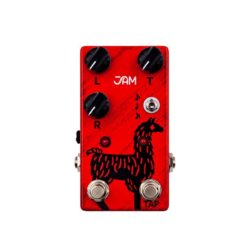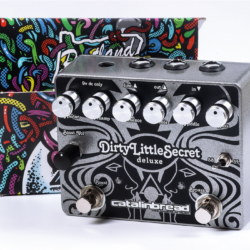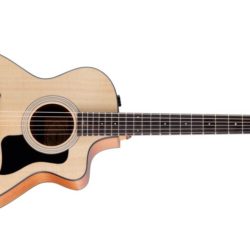
Jam Pedals Delay Llama Mk3 Review
In this thoughtful, understated upgrade of the original Delay Llama, those sneaky folks at Jam Pedals have brought much of the essential bonus functionality of 2020’s Delay Llama Xtreme to a more compact pedal with a simple and familiar layout. Though the new Llama looks a lot like its predecessors, the Mk3 includes a tap-tempo footswitch, subdivisions switch, and a hold function—simple, practical, but critical improvements that enhance its functionality and musical capabilities considerably. Most importantly to those that have always savored the sound of the original Delay Llama, it retains the same analog delay engine, driven by bucket-brigade chips that are faithful reproductions of the beloved Panasonic MN3205. This architecture means the Mk3 is capable of a maximum delay time of 600 ms. So, you’re guaranteed the warm, full-bodied sound that, over the years, attracted major players like Jim Campilongo, Marc Ribot, and Adrian Legg to the original Delay Llama.”Best perhaps, the pedal is a doddle to dial in and use as desired.”Knob and TubeThe core of the Delay Llama Mk3’s functions still reside in the three knobs for delay time (T), repeats (R), and level (L). Below these, the previous single on/off footswitch has been moved to the lower-left corner of the enclosure and is now paired with a tap-tempo footswitch situated in the opposite corner. Needless to say, it requires nimble footwork and practice to avoid hitting both. But essentially, the setup works. Just above the tap button, a 3-way toggle lets you divide the tapped tempo selection into eighth, quarter, and dotted-quarter notes. Holding down the tap footswitch engages a self-oscillation mode.Inside the enclosure, there’s an internal trimmer that sets the delay trail’s fade-out time (the amount of time the delayed signal takes to decay once you switch off). Another trim pot sets the maximum number of repeats. Further, a nifty trick allows you to change the pedal from its preset (factory) true-bypass mode to a buffered mode that enables trails (this involves removing the power cable, pressing and holding the tap button, then reinserting the power cable until three LED blinks tell you the buffered mode has been set). Power comes via standard center-negative 9V adaptor, and the unit draws 120 mA.Llama Rama Ding DongIn practice, the Delay Llama Mk3 reveals a superbly characterful and juicy-sounding analog delay voice that shines—even within a product category that’s rich with enticing delay sounds. At its essence, there is very little to criticize in the design or sound. The 600 ms maximum delay time is pretty standard for the bucket-brigade crowd and supplies enough spacey echoes to suit just about everything save for ultra-expansive, otherworldly soundscaping. What’s best, perhaps, is that the pedal is a doddle to dial in and use as desired.Though many deep texturalists need über-complex delays with a boatload of extra parameters and presets, many guitarists relish the straight-ahead pleasures of an analog delay pedal—where you settle in, fine-tune the repeats and blend, and dig the atmosphere without wondering about the little stuff. That’s exactly where the Delay Llama Mk3 transported me with ease. I’m not exactly a delay fanatic, yet I did not want to turn this thing off. Its sound and the effect itself inspired new riffs—and plenty of smiles—from the start. And it only got more enjoyable the more I played it. Very few of its design shortcomings upset the bliss of playing the Delay Llama Mk3. The taper of the repeats knob accelerates pretty quickly from the fully anti-clockwise position, so dialing just three repeats instead of six or eight can be tricky. Still, most such nuances can be managed with practice and a light touch. The VerdictThe Delay Llama Mk3, which is one of the last BBD delay pedals still being handmade with through hole components, is a great-sounding analog delay pedal that easily dishes late ’70s and early ’80s bucket-brigade goodness with a low noise floor and useful tap-tempo functionality. The repeats pot taper could benefit from some fine-tuning, and the enclosure is a bit narrow for negotiating both the bypass and tap-tempo footswitches cleanly. But the Delay Llama Mk3 is still a standout in the analog delay camp, any way you cut it.
Read more »
The Yamaha hand-crafted FG9 M acoustic combines old-world craftsmanship with state-of-the-art technology
Elegant, pro-quality six-string boasts Adirondack spruce top, mahogany back, sides and neck, Japanese-inspired appointments and more
Read more »
Catalinbread Unveils the Dirty Little Secret Deluxe
Designed to offer the ultimate Marshall Plexi emulation and fully-customizable amp-in-a-box experience.Catalinbread’s original DLS circuit has been tweaked and upgraded throughout, now featuring a phase inverter, power amp sim and output transformer as well as some new features and the most requested modifications for the original. One such addition is a toggle switch on the outside to select between Super Lead and Super Bass modes, and they’ve also externalized the Presence knob to easily dial in your preferred Marshall flavor. Also added is a piece of the Dirty Little Secret—a single preamp tube simulator—as a built-in boost circuit that can be used independently of the main circuit. You can run the boost and DLS in any order you like; put the boost before the DLS for a high-powered saturated tone or after to pummel the front end of your amp. A new tightness knob lets you shave off the sub-bass for a little extra clarity or completely attenuate the low end for some cool thrash metal tones. A Line Out jack gives you a dedicated +10dB output that you can use with a mixer or DAW, and you can use both outputs simultaneously. Between the Boost, order selector and the external Super Lead/Super Bass modes, the Dirty Little Secret Deluxe is engineered to be a total performance tool that does the line justice.Catalinbread Dirty Little Secret Deluxe$299.99Learn more: https://catalinbread.com/
Read more »
TOOL Bassist JUSTIN CHANCELLOR’s MTVOID Project Announces ‘Matter’s Knot, Pt. 1’ Album
MTVOID, the duo featuring TOOL’s Justin Chancellor and SWEET NOISE/SERCE vocalist Peter Mohamed, will release its sophomore album, “Matter’s Knot, Pt. 1”, on November 10 via Lobal Orning.
“‘Matter’s Knot, Pt. 1’ is our pan-dynamic tapestry of sound and thought, twisted together and pulled taut, a co…

METALLICA Shares Pro-Shot Video Of ‘Dirty Window’ Performance From Montreal During ‘M72’ Tour
Professionally filmed video of METALLICA performing the song “Dirty Window” on August 13 at Stade Olympique in Montreal, Quebec, Canada can be seen below.
METALLICA rescheduled last Sunday’s (September 3) show in Arizona after frontman James Hetfield tested positive for COVID.
The concert, part of t…

Taylor 112ce-S Review
There’s nothing new about Taylor building great, affordable guitars. Even instruments like the modest GS Mini always feel inviting and capable of inspired musical moments. The build-quality in these Tecate, Mexico-constructed guitars always impresses, too. But taking a spin with the new 112ce-S suggests that Taylor has reached another level of balance to go with their sense of affordable guitar craft. The most substantial change in the newest addition to Taylor’s entry-level 100 Series is the introduction of a layered sapele back and sides, which pair nicely with solid, matte Sitka spruce tops to generate a warm, bright personality. But that combination seems to achieve a sort of ideal in the form of the 112ce-S grand concert, which manages to sparkle sonically, but also feel incredibly comfortable and impeccably playable in ways that you see in much more expensive instruments.Made to CradleRegardless of your tone aspirations, it’s impossible to argue the comfort of cradling a grand concert body. Generally speaking, a grand concert is about the size of a classical body shape (which has a few centuries of refinement behind it), and it won’t feel entirely alien to a player who’s spent most of their time on the electric side of the fence. Nor will it threaten to dislocate your shoulder after a couple of hours the way a dreadnought can if you’re of smaller stature. And the way it fits more naturally against the body lends itself to more nuanced playing techniques. The 112ce-S seems to multiply all these benefits. And, at times, it genuinely feels like an extension of your own body.The pleasure of holding the 112ce-S is enhanced even more by the excellent playability of the instrument. We’ve grown used to experiencing unsurpassable playability on Taylor’s high-end instruments—most notably that magic blend of low action and freedom from fret buzz that facilitates fast and easy fretting and navigation over the length of the fretboard. The 112ce-S couldn’t live much more squarely in that sweet spot. Intonation on our review guitar is dead on. And, remarkably, the Taylor traveled from our video team in a sweltering hot Nashville to cool, foggy Northern California and arrived almost perfectly in tune. I’m not sure exactly what Taylor does to make these instruments so stable. My tour of the company’s California plant some years back showcased a combination of CNC manufacturing and careful hands-on touches that yielded very high-quality instruments. My guess is that the Tecate plant is using the very same construction techniques to excellent effect.Evidence of careful craftsmanship is easy to see elsewhere. Apart from a trace of errant glue spread around the kerfing, the guitar looked perfect on the inside. Outside, the guitar is pretty much flawless. The 3-piece maple neck, in particular, is a gem. It’s capped with an ebony fretboard, and its lovely profile—almost a cross between a C and an oval—fills the hand and feels substantial without feeling too bulky. Expressive moves like finger vibrato feel natural and easy. And like the rest of the guitar, the neck feels conceived to eliminate playing fatigue. In concert with the low action, it makes playing for hours a breeze. The classy looking Venetian cutaway has its benefits, too. It’s easy to play a lead right up the 19th fret and hear that top note ring clear, true, and free of buzz.The Middle GroundGrand concert bodies, in general, have benefits beyond comfort. In my experience, they tend to record exceptionally well, especially when mahogany is in the mix. They aren’t too bossy or boomy. They shimmer when recording rhythm parts, and they are even and detailed when tracking fingerstyle. The 112ce-S is capable of all these same feats, but it really excels in the fingerstyle realm. The guitar’s midrange leanings give the 3rd, 4th, and 5th strings a snappy reaction to a soft touch. The top two strings ring with a warm and chimey glow around pronounced transients. And the bottom string blooms with overtones that surround a round and robust transient attack. It’s a beautifully balanced instrument in this setting. It awakens and enlivens chord melodies that move up and down the length of the neck. It feels just as balanced and alive in capo’d settings, and requires little to no retuning as you move a capo around the neck. In stage performance terms, these attributes make the 122ce-S something of a fingerstylist’s dream.Strumming is less flattered by the Taylor’s midrange-forward voice, though it is certainly far from brash or unpleasant. The same pretty bass response that you hear in fingerstyle settings remains evident when you take a flatpick to the 112ce-S. But the strong midrange that makes the 112ce-S feel so alive in soft fingerstyle situations does become an especially strong flavor if you hit the strings hard. The guitar sounds much prettier when you use a lighter touch and a thin flatpick. Played this way, it’s easy to hear how the 112ce-S would shine amid stacked rhythm parts on a recording or when tracking alternate, overdubbed chord voicings with a capo. Strummers with a heavy hand, or for whom that style is a foundation of their playing, may want to look elsewhere. But if strumming is just a part of your songwriting vocabulary, the 112ce-S may fit perfectly into your mixed approach.The VerdictFor just under 800 bucks, the Taylor 112ce-S is, in most respects, a steal. And while it’s effectively an entry-level Taylor, I would have no qualms about touring or recording with this thoughtfully executed grand concert. The Expression System 2 electronics make it good-to-go for gigging, even though they benefit from careful EQ from the onboard controls or a pedal to eliminate boxiness. However you put the 112ce-S to work, though, it’s a surefire pleasure—particularly when you consider the impressive value it represents.Taylor’s Best Under $800?! The Taylor 112ce-S Grand Concert Demo | First LookTaylor Limited-edition 112ce Acoustic-electric Guitar – Natural Sapele
Read more »
TIM ‘RIPPER’ OWENS On Battling Detractors: ‘I’ll Always Have Something To Prove’
By David E. Gehlke
Possessor of one of the finest voices in American metal, Tim “Ripper” Owens has been a bit of a musical nomad since his 2003 departure from the band that put him on the map, JUDAS PRIEST. A long-term situation has unfortunately eluded the Akron, Ohio native, namely high-profile st…

FESTIVAL PREVIEW: Burn It Down Festival 2023
Since its establishment in 2018, Burn It Down Festival have slowly grown to become a solid name in the UK festival circuit. Held in the idyllic seaside of Torquay, September sees a…
Read more »
LES CLAYPOOL’S FROG BRIGADE Releases Pro-Shot Video Of ‘Pigs’ Performance From PINK FLOYD’s ‘Animals’
As they prepare for “The Hunt For Green October” tour, kicking off on Wednesday, October 11 in Oakland, California for their final Bay Area show of the year, LES CLAYPOOL’S FEARLESS FLYING FROG BRIGADE has unveiled a pro-shot video capturing their rendition of PINK FLOYD’s “Pigs” live from the Missi…
Read more »
Video Premiere: Trounce – “The Crippled Saint”
Epically inclined post-black metallers Trounce, um, defeat your expectation their new video for the song “The Crippled Saint.”
The post Video Premiere: Trounce – “The Crippled Saint” appeared first on Decibel Magazine.
